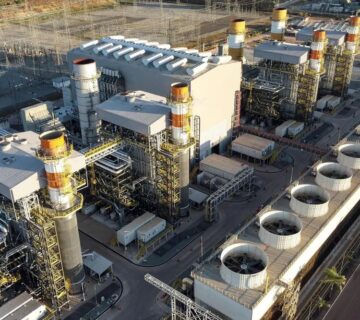Paulo Arbex, presidente da ABRAPCH em publicação especial da agência internacional Bnamericas.
Confira abaixo:
Thermoelectric power generation in Brazil has almost doubled in a year, jumping from 7,881MWa to 14,279MWa of the total power load, according to the latest available data from national grid operator ONS compiled by BNamericas.
Last Thursday, the share of thermoelectric power in the country’s power load (69,572MWa), including the Angra 1 and 2 nuclear plants, reached 20.5%, up from 13.8% a year earlier.
The increase in thermal power use reflects the severe drought Brazil has experienced in recent months, with rainfall at its lowest in over 90 years in the areas of some of its main hydro reservoirs. According to local experts, the risk of energy rationing is a reality.
The situation of hydroelectric reservoirs is most critical in the southeast/center-west subsystem, where the energy storage level (EAR) is at 32.2%.
Given the alarming scenario, authorities have been forced to dispatch more thermoelectric power, which is more expensive.
As a result, electric power watchdog Aneel on Friday announced the red flag tariff system (level 2) for June, with a cost of 6.243 reais (US$1.19) per 100kWh.
“June starts with the main reservoirs of the SIN [national interconnected system] at lower levels for this time of year, which points to a horizon with reduced hydroelectric generation and increased thermoelectric production. This situation puts pressure on the costs related to hydrological risk (GSF) and the price of energy in the short-term market (PLD),” the regulator said in a statement.
On May 27, hydroelectric generation accounted for 66.1% (45,969MWa) of Brazil’s total power load, down 16.8 percentage points from a year earlier.
On the other hand, wind power’s share significantly rose in the past year, reaching 12.2% of the national load (8,453MWa) last Thursday, from 2.38% (1,360MW) on May 27, 2020.
 Power generation on May 27, 2020/2021. Source: BNamericas based on ONS data.
Power generation on May 27, 2020/2021. Source: BNamericas based on ONS data.
“Wind power has a specific importance because it is complementary to hydroelectric power, since the time of year with the least rainfall is the time of best winds, which helps preserve reservoirs just when they are most needed,” Elbia Gannoum, the CEO of local wind power association Abeeólica, told BNamericas.
“Since 2013, wind power has allowed the northeast system to become even an energy exporter during the season of stronger winds and, on record days, wind power already accounts for 17% of the consumption of the SIN.”
Paulo Arbex, the president of Brazilian small hydro plants association Abrapch, told BNamericas this is a “self-imposed” crisis, as Brazil, which accounts for 12% of the world’s fresh water, stopped building hydroelectric plants with reservoirs in the 1990s.
“There is only one solution for the water crisis: Brazil must go back to building small and large hydroelectric plants with reservoirs,” he said, pointing out the cost of thermoelectric power is up to 10 times greater than that of hydro plants.
Larissa Rodrigues, project and product manager at Brazilian sustainability-focused non-profit organization Instituto Escolhas, told BNamericas Brazil must prioritize wind, solar and biomass power plants, while enhancing the management of water reservoirs.
“Increasing the use of thermoelectric plants, as foreseen in [state holding] Eletrobras’ privatization … will only make power bills more expensive for consumers,” she said.
Rodrigues emphasized that the environmental costs of thermal plants reduce their profitability. “When gas emissions and water use are taken into consideration, there is no return for the investor. So the consumer will pay twice, considering the climate issue.”
According to the ONS, 91 thermoelectric plants generated power on May 27. The top 10 were PQU SPSP TERM (1,298.44MWa), Angra 2 (1,214.64MWa), Norte Fluminense (823.98MWa), Angra 1 (647.38MWa), Termopernambuco (525.91MWa), B. Fluminense (523.38MWa), TermoRio (433.84MWa), UTE Mauá 3 (368.37MWa), PQU MGMG TERM (346.08MWa) and UTE Pampa Sul (344.83MWa).
Another 100 thermoelectric plants were out of operation on the same day.
And 104 thermoelectric plants totaling 8GW of capacity are planned to begin operations in the coming years, mostly in the north and southeast regions. On that list is Marlim Azul (566MW), belonging to a consortium formed by Pátria Investimentos, Shell and Mitsubishi Hitachi, and Gás Natural Açu’s GNA I (1.3GW) and GNA II (1.6GW) in Açu port, both in Rio de Janeiro state.
DEMAND GROWTH
Meanwhile, the ONS foresees a 6.6% increase in the national power load in June from a year earlier, driven by the economic growth expectations for the rest of the year, the grid operator said in a statement.
The load forecast indicates that the north region should expand 8.8% to 5,852MWa. Next comes the northeast, with an increase of 7.7% to 10,617MWa, followed by the southeast/center-west, with 6.3% to 38,005MWa. The south is projected to see 5.7% higher consumption at 11,317MWa.
At the end of June, the volume of reservoirs should reach 83.3% of capacity in the north; 69.8% in the south; 54.2% in the northeast; and 28.8% in the southeast/center-west, according to the ONS.
Fonte: Bnamericas
31.05.2021







No comment